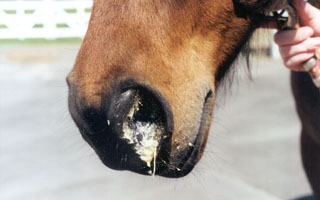
| This horse has some significant nasal discharge. This discharge would be described as purulent and is associated with a strangles infection. |
Causative Agent:
This disease is caused by the gram-positive bacteria, Streptococcus equi.Clinical Signs: Fever and nasal discharge, noted 2-6 days after initial exposure, are the first signs of infection. With time, the lymph nodes under the throat and neck regions swell and eventually turn into abscesses. These abscesses often rupture and drain a thick, yellow discharge. Some of these abscesses can actually block normal air and feed passage. When this occurs, the horse will often extend its neck, be unable to eat, and have profuse salivation and feed material coming out of the mouth or nose. Abscesses that go internally to any other organs, are called "bastard strangles." If this occurs, the animal can die because of complications associated with the internal abscesses.
Disease Transmission: This bacteria is spread by direct contact with infectious material. Contaminated hands, buckets, halters, watering troughs, and other equipment are primary sources for disease transmission.
Diagnosis: This disease can often be identified just by looking at the clinical signs. However, a specific diagnosis is made from culturing the discharge from the nose or abscess.

|
|
Treatment: Strangles is a difficult problem to treat correctly in every situation. With this in mind, below are some general suggestions based on different circumstances.
- Give Procaine penicillin G for prevention.
- Treatment with Procaine penicillin G, if begun early in the disease progression, will help stop additional problems.
- In these cases, the abscesses should be allowed to mature and drain. If necessary, the lower portion of the abscess can be lanced and drained.
- Giving antibiotics at this time tends to prolong the healing process.
- Any animal that has difficulty breathing, eating, or is severely sick, should receive Procaine penicillin G.
* All cases should have veterinarian intervention.
Prevention: Isolating infected or suspect animals, and using proper hygiene techniques when handling these horses, is a must. There are also two types of vaccines available to help with prevention.